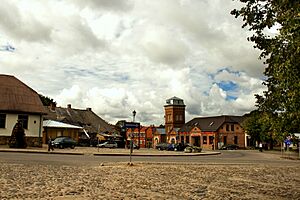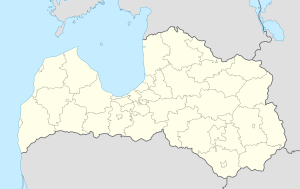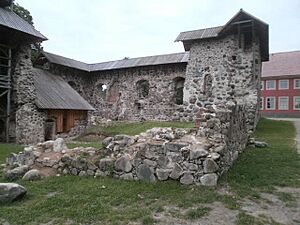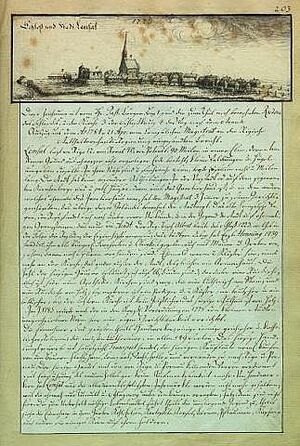Limbaži facts for kids
Quick facts for kids
Limbaži
|
|||
|---|---|---|---|
|
Town
|
|||

Limbaži old town
|
|||
|
|||
| Country | |||
| District | Limbaži municipality | ||
| City status | 1385 | ||
| Area | |||
| • Total | Lua error in Module:Wd at line 1,575: attempt to index field 'wikibase' (a nil value). km2 (Formatting error: invalid input when rounding sq mi) | ||
| • Land | Lua error in Module:Wd at line 1,575: attempt to index field 'wikibase' (a nil value). km2 (Formatting error: invalid input when rounding sq mi) | ||
| • Water | Expression error: Unexpected < operator. km2 (Formatting error: invalid input when rounding sq mi) | ||
| Population
(2024)Lua error in Module:Wd at line 1575: attempt to index field 'wikibase' (a nil value).
|
|||
| • Total | 6,613 | ||
| Time zone | UTC+2 (EET) | ||
| • Summer (DST) | UTC+3 (EEST) | ||
| Postal code |
LV-4001
|
||
| Calling code | 640 | ||
| Website | http://www.limbazi.lv | ||
Limbaži is a town in the Vidzeme region of northern Latvia. It has a population of about 6,600 people. Limbaži is located 90 kilometers (56 miles) northeast of Latvia's capital city, Riga.
During the Middle Ages, Limbaži was a very important fortified town. It had strong stone walls and was second in importance only to Riga in the region known as Livonia.
Contents
Understanding the Name of Limbaži
The name "Limbaži" is believed to come from the Livonian language. It's thought to be a Latvian version of the Livonian word Lembsel or Lemesel. This word means "wide island in a forest swamp." The German name Lemsahl also comes from this Livonian word.
There's also a fun story about how the name might have come about. According to folk etymology, in the 17th century, a Swedish minister heard the Latvian words "Limba" and "āži" (which means 'male goats'). He supposedly thought this was the town's name, and so it became "Limbaži."
Limbaži Through the Ages: A Historical Journey
In ancient times, Limbaži was a settlement of the Livonian people called Lemisele. It was part of a larger area known as Metsepole. In the early 13th century, Bishop Albert and the Teutonic knights arrived. They destroyed the old village while taking over Metsepole. Then, they built a castle, and a new city called Lemsahl grew around it.
Medieval Limbaži: A Busy Trading Hub
For a long time, until the early 1500s, ships could sail right up the Svētupe river to Lemsahl. Ships from places like Lübeck and Copenhagen came to trade goods. They exchanged things like honey, wax, lumber, grain, and animal furs. This made the small trading camp around the castle grow into a large town.
Lemsahl even became a member of the Hanseatic League, which was a powerful group of trading cities in northern Europe. Each year, important meetings were held in Lemsahl for leaders from all over Livonia. The city also hosted at least three big fairs every year. During these fairs, the town could have as many as 20,000 people!
The Archbishops of Riga also used Lemsahl as their spring home. To protect the bishop and the busy trading center, the city was surrounded by walls. At this time, Lemsahl was the second largest city in Livonia, right after Riga. The Limbaži Castle is one of the oldest fortified buildings in Latvia.
However, by 1500, the Svētupe river became too shallow for ships. Trade moved to other places, and Lemsahl started to decline. During the Livonian War, the city suffered greatly. Forces led by Ivan the Terrible burned Lemsahl in 1558. Its residents had to hide in nearby forests and swamps. The city was burned again by the Swedes in 1567 and by the Russians in 1575. In 1602, the Swedes and Poles fought over the city, completely destroying its walls and defenses. After all these wars, the city was so ruined that only three houses and a few people remained.
Limbaži in the 18th and 19th Centuries
While under Swedish rule, the village was renamed Limbaži sometime in the 17th century. During the Great Northern War, the Vidzeme region was badly damaged by the forces of Peter the Great. But, a story says that the Russian army got lost in a thick fog while looking for Limbaži. After going in circles, they thought the village might not exist and moved on. So, Limbaži was saved from the war.
The city completely burned down again in 1747. After this fire, the city's current layout began to take shape. In the 19th century, Limbaži started to grow again. In 1821, there were 674 people, but by 1900, there were about 2,000.
In 1876, a hat-maker named A. Tīls opened "Limbažu filcs" (Limbaži Felt). This was the town's oldest company and provided jobs for many generations. The first town library was built in the late 19th century, and several publishing houses opened. The biggest one was K. Paucīsis Press.
Limbaži in the 20th Century
After World War I, Limbaži continued to grow as a center for trade and crafts. A much-needed rail line to Riga opened in 1934. A 50-bed hospital opened in 1936. The House of Unity (Latvian: Vienības nams), a cultural center, was opened in 1939.
During World War II, Limbaži was occupied by Nazi Germany from July 4, 1941, to September 26, 1944. During the Soviet period, the population grew to 8,000. Many five-story Soviet-style apartment buildings appeared in the 1960s. Limbaži became a factory town with "Lauktehnika" (a farm machinery center), "Limbažu filcs" (the felt hat factory), and "Limbažu piens" (one of Latvia's largest milk processors).
Population Changes in Limbaži
| Historical population | |||||||||||||||||||||||||||||||||||||||||||||||||||||||||||||||||||||||||||||||||||||||||||||||||||||||||||||||||||||||||||||
|---|---|---|---|---|---|---|---|---|---|---|---|---|---|---|---|---|---|---|---|---|---|---|---|---|---|---|---|---|---|---|---|---|---|---|---|---|---|---|---|---|---|---|---|---|---|---|---|---|---|---|---|---|---|---|---|---|---|---|---|---|---|---|---|---|---|---|---|---|---|---|---|---|---|---|---|---|---|---|---|---|---|---|---|---|---|---|---|---|---|---|---|---|---|---|---|---|---|---|---|---|---|---|---|---|---|---|---|---|---|---|---|---|---|---|---|---|---|---|---|---|---|---|---|---|---|
|
|
|
|||||||||||||||||||||||||||||||||||||||||||||||||||||||||||||||||||||||||||||||||||||||||||||||||||||||||||||||||||||||||||
Famous People from Limbaži
Many notable people have connections to Limbaži:
- Kārlis Baumanis (1835–1905) was a composer. He wrote Latvia's national anthem, "Dievs, svētī Latviju!"
- Jānis Kalniņš (born 1991) is an ice hockey player.
- Mārcis Ošs (born 1991) is a footballer.
- Jānis Bērziņš (born 1993) is a basketball player.
Places to See in Limbaži
If you visit Limbaži, here are some interesting places:
- Limbaži Old Town: You can still see parts of the old town wall.
- Ruins of the Archbishop's Castle: Explore the remains of the historic castle.
- Limbaži History Museum: Learn more about the town's past.
- Livonian Hill-Fort at Ķezberkalns: See an ancient fortified settlement.
- St. John Lutheran Church (Latvian: Sv. Jāņa luterāņu baznīca): A beautiful historic church.
- Kārlis Baumanis' Grave and Monument: Visit the resting place of the national anthem's composer.
- Limbažu Lielezers (Lake Limbaži): Enjoy the scenery around the lake.
- National Olympic Training Center: This center is for canoeing and kayaking athletes.
Limbaži's Sister Cities Around the World
Limbaži has "twin town" or "sister city" relationships with several cities in other countries. This means they share cultural and educational exchanges.
 Alver, Norway
Alver, Norway Anklam, Germany
Anklam, Germany Klippan, Sweden
Klippan, Sweden Luninets, Belarus
Luninets, Belarus Panevėžys District Municipality, Lithuania
Panevėžys District Municipality, Lithuania Sande, Norway
Sande, Norway Volkhov, Russia
Volkhov, Russia
Images for kids
See also
 In Spanish: Limbaži para niños
In Spanish: Limbaži para niños










